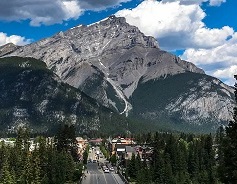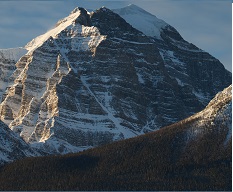
Scrambling
Banff National Park
There are good scrambling peaks in the Banff National Park that range from easy with little exposure to steeper climbs with sections of serious exposure and/or loose rock. Some of the most popular scrambles, Mount Rundle and Cascade Mountain, which overlook the town of Banff, have well-established, relatively straightforward routes. Experienced scramblers can also ascend Mount Temple near Lake Louise via its standard route by mid-summer. Those three scrambles are described in that section.
Climbing and Safety Tips
- Tell a friend – Always leave a detailed trip plan with a reliable person. Include trip destination, expected time of return, vehicle description, license plate number, parking location and the Banff Dispatch phone number: 403-762-1470.
- Start early – Take advantage of cool mornings for hiking and allow for the best chance to summit and descend before afternoon thundershowers develop.
- Turn-around time – Plan the trip with enough time to return home before dark. Turn back at a set time regardless of whether or not the summit was reached.
- Stay together – Parties that split up are one of the most common causes of problems that result in need for assistance. If your party must separate, make specific arrangements to reconnect.
- Weather – Mountain weather changes quickly. It often snows here in the summer! Climbing a high altitude peak is the same as travelling to a different latitude and it could feel like winter. No matter what the forecast says, always carry a backpack with protective clothing—see “Gear List”.
- Take lots of water – The higher you climb, the less likely you are to find water
- A matter of perspective – The further you stand back from a mountain, the more you can see. For a better view of the entire climb, study the route from a distance wherever possible. Once on the climb, close-up features can block your view of the route ahead. Cliffs hidden from sight can block the way. Well-used footpaths can lead you in the wrong direction. Pay attention!
- Look back – After a long day, the way down always appears different. While ascending the route, make a conscious effort to look back and memorize landmarks for the way down. See [look back] reminders in route description.
- Descent – Descend by the same route you climbed. Changing the line of the descent route by even a few degrees at the top of a mountain can lead you to totally unfamiliar terrain by halfway down.
- Avoid shortcuts – Stay on route! Shortcuts in the mountains can lead to serious accidents.
- Lightning – Summer electrical storms are common in the mountains. Lightning strikes and associated ground currents can be deadly. Lightning storms often occur on warm afternoons, and strikes are most likely to hit peaks, ridges, and prominent objects, such as climbers, on open slopes.
If you hear an approaching thunderstorm:
Descend immediately to the safety of lower elevations.
If caught in an exposed area by a thunderstorm:
- Go to a spot away from any dangerous drop-off.
- Crouch down so your head is below the surrounding terrain.
- Sit on your pack at a distance from any metal belongings.
- Keep your feet together and try not to touch the ground with any other parts of your body.
- Do not shelter under overhanging rocks or caves in an electrical storm. The current will pass through you as it grounds through the rock above and below.
Gear List
- Lightweight rain/wind jacket
- Sweater
- Hat and gloves
- Helmet
- Sturdy hiking boots
- Food/lunch
- Sunglasses and sunscreen
- Water (take enough for a long day—there is often no water source on route)
- Trekking pole(s)
- Light first aid kit (especially tape)
- If you are wearing shorts, take lightweight wind pants
- Headlamp (in case of a late return)
- Cell phone (variable reception along the route), satellite phone, and/or personal locator beacon
- A copy of this brochure!
- Less experienced scramblers/climbers may want the added safety of a climbing rope/harness for the crux section of Mount Temple.
- A climbing ice axe and crampons are likely required if there is snow on the route.
Emergencies
Out overnight
If, for any reason, your party is detained, be prepared to spend at least one night out (always carry spare clothing and high-energy food). Summer nights at altitude can be cold and uncomfortable, but are seldom life-threatening. If someone is injured, focus most of the group’s resources on conserving that person’s warmth and energy until help arrives.
Accidents
- If a serious accident occurs, respond with care—do not rush.
- Stabilize the injured person. Take measures to protect them from further danger. Provide them with shelter.
- If medical evacuation is required, call the emergency numbers below or send a person for help. Ideally, have someone remain at the scene to care for the patient. If you have a cellular phone, try it!
- Ensure the reporting person has all necessary information (exact location of patient, nature of injury and time of accident), and remembers details like car keys.
Emergency Numbers
- 911 (request help for a mountain emergency in Banff National Park from Parks Canada’s mountain rescue team).
- (403) 762-4506 (24hrs - emergency only) which will connect you directly to the Banff Emergency Dispatch Centre.
Cell phone coverage is not reliable throughout the national park.
Further Information
- Banff Visitor Safety Specialists provide trip planning and mountaineering advice. Call 403-762-1470 or drop by the Warden Office in the Banff Industrial Compound.
- Visit or call a Parks Canada visitor centre.
- Guidebooks available in local bookstores:
- Scrambles in the Canadian Rockies by Alan Kane, describes moderate mountain climbs in the Rockies
- Rockies Central Guide by David P. Jones
- The 11,000ers of the Canadian Rockies by Bill Corbett
- Private guide services offer guided climbs in the Mountain Parks
- Trail condition report
- Safety information
- The Mountain Conditions Report (MCR)
Scrambler's Guides
- Date modified :


